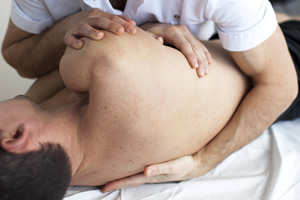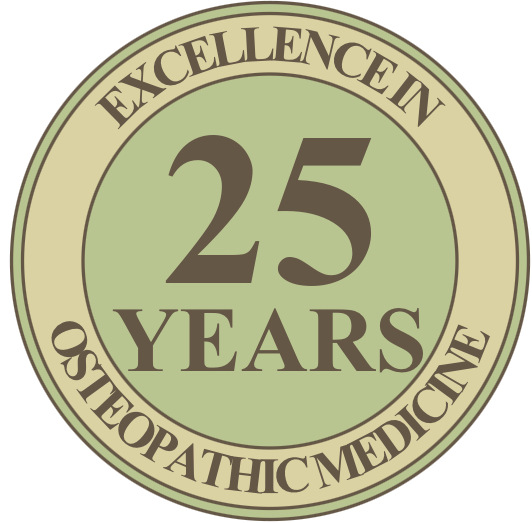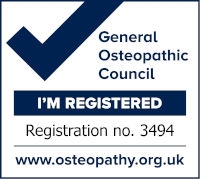Gravity and Physical & Emotional Structure in Osteopathic Medicine
 Any trauma to the body is recorded as changes in internal structure. With slight damage, structures are nearly able to resume their original positions after healing. But even slight displacements have cumulative and long-term effects, especially if there is a shift in the way weight is carried (a change in the relation to gravity). In fact, it is possible that all traumas to the body alter the relation to gravity by causing deviations from the ideal pattern, the form we have inherited to enable us to cope with gravity. Even a small change in alignment and movement will result in compensatory changes throughout the body. Patterns of neural activity, blood and lymph flow, and muscular contraction will be altered. If recovery is prolonged, certain muscles will atrophy from disuse, others will become hypertoned from being overworked. Because muscles act as pumps, moving blood and lymph, the presence of immobilised and flaccid muscles will reduce the nutrition and oxygenation of cells and tissues. When a muscle is chronically shortened, it gradually loses its ability to relax. Tension will always be present. Connective tissue fibrils will be laid down to thicken and strengthen structures that are called upon to provide extra support. Traces of altered structure and function can be retained indefinitely after an injury heals. A widely held misconception in our culture is that these accumulated imbalances, and the discomfort associated with them, are an inevitable effect of ageing, and cannot be reversed. This is not the case.
Any trauma to the body is recorded as changes in internal structure. With slight damage, structures are nearly able to resume their original positions after healing. But even slight displacements have cumulative and long-term effects, especially if there is a shift in the way weight is carried (a change in the relation to gravity). In fact, it is possible that all traumas to the body alter the relation to gravity by causing deviations from the ideal pattern, the form we have inherited to enable us to cope with gravity. Even a small change in alignment and movement will result in compensatory changes throughout the body. Patterns of neural activity, blood and lymph flow, and muscular contraction will be altered. If recovery is prolonged, certain muscles will atrophy from disuse, others will become hypertoned from being overworked. Because muscles act as pumps, moving blood and lymph, the presence of immobilised and flaccid muscles will reduce the nutrition and oxygenation of cells and tissues. When a muscle is chronically shortened, it gradually loses its ability to relax. Tension will always be present. Connective tissue fibrils will be laid down to thicken and strengthen structures that are called upon to provide extra support. Traces of altered structure and function can be retained indefinitely after an injury heals. A widely held misconception in our culture is that these accumulated imbalances, and the discomfort associated with them, are an inevitable effect of ageing, and cannot be reversed. This is not the case.
The way the body responds to physical trauma applies equally to the response to an emotional mishap or to a chronic psychological state. Psychological attitudes are always represented in the body structure. Fear, grief, and anger each have a characteristic pose and pattern of movement, sometimes referred to as 'body language’. An emotional response immediately precipitates contraction of flexor muscles and movement away from structural balance. Once this happens, gravity takes over and pulls the structure downward, making the body shorter. Each imbalance must be compensated for by displacements of other parts of the body. Tension and altered function are always present. Recovery from an emotional shock requires flexibility and resiliency of the musculoskeletal system, an ability to return the body toward the ideal pattern of relationship with gravity. If an individual continues to dramatise an emotional situation, the physical body becomes set into a psychological pattern. Once these changes have taken place, the physical attitude becomes invariable, involuntary. Movements, including respiration, reveal the emotional turmoils. In a balanced body, inspiration involves lengthening of the entire spine, from the sacrum all the way up to the cranium. When movements are restricted, individuals can no longer feel an emotion as an emotion. No longer can they have a natural response to an immediate situation and then get on with their life. Instead, they live, move, and have their being in an attitude. No amount of discussion, thought, or mental suggestion can change the pattern. To escape from their chronic fear, grief, or anger, the physical tone of the muscles and the structure in relation to gravity must be changed.
 The imbalances resulting from physical or emotional trauma can lead to a whole realm of chronic problems for which conventional medicine has little to offer. The more serious of these, arthritis, high blood pressure, even cancer, are whole-system phenomena that cannot be understood by examining parts rather than relationships. And gravity is a part of the whole that has been given relatively little attention. As an example, consider the relation of the head to gravity. For various reasons, most of us hold our heads tipped forward, with our cervical spine bent. The vertebral artery is curved instead of straight, and its lumen is narrowed, restricting the cervical circulation. Less nourishment reaches the brain and sense organs of the head. The hydrostatic compartments of the brain (ventricles) are affected. The sympathetic-parasympathetic balance can be influenced, leading to digestive complaints. Tensions may lead to headaches and bursitis. The functioning of the spinal cord itself may be impaired at the important region where it descends from the brain. The electric and magnetic fields of the brain and spinal nerves may have their patterns distorted by cervical imbalances.
The imbalances resulting from physical or emotional trauma can lead to a whole realm of chronic problems for which conventional medicine has little to offer. The more serious of these, arthritis, high blood pressure, even cancer, are whole-system phenomena that cannot be understood by examining parts rather than relationships. And gravity is a part of the whole that has been given relatively little attention. As an example, consider the relation of the head to gravity. For various reasons, most of us hold our heads tipped forward, with our cervical spine bent. The vertebral artery is curved instead of straight, and its lumen is narrowed, restricting the cervical circulation. Less nourishment reaches the brain and sense organs of the head. The hydrostatic compartments of the brain (ventricles) are affected. The sympathetic-parasympathetic balance can be influenced, leading to digestive complaints. Tensions may lead to headaches and bursitis. The functioning of the spinal cord itself may be impaired at the important region where it descends from the brain. The electric and magnetic fields of the brain and spinal nerves may have their patterns distorted by cervical imbalances.
While physical patterns can become solidified from psychological attitudes, the converse is also true. A physical trauma, for example a childhood fall down basement steps, a slip from a bicycle (both a result of gravity), or a devastating motor crash, can influence the emotional state. A relatively simple accident which nevertheless leaves the body misaligned and out of balance can affect the psychological sense of the individual. The kinesthetic body feel inadequate, and the physical structure projects an image of inadequacy.
The goal of any osteopath is an organism that is balanced in space around a vertical line, and that can move with ease and efficiency. When muscular efficiency is optimal, the expenditure of energy by the body in any activity - working, walking, running, or whatever - is minimal. Hence there is more energy available for other vital functions such as thought, digestion, circulation, tissue maintenance, repair, defence against disease, etc. Along with this greater efficiency comes a greater psychological ease and emotional security. The integrated body not only accomplishes a multitude of tasks, but it carries them out simultaneously, effortlessly, joyously.













